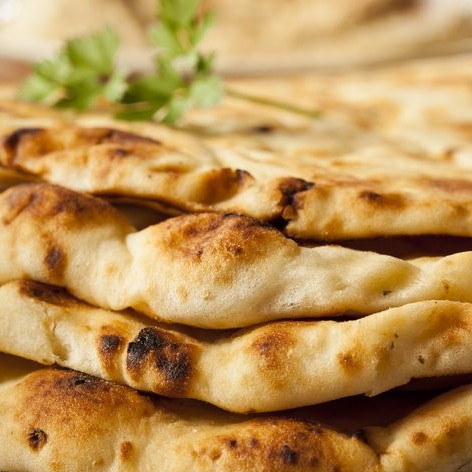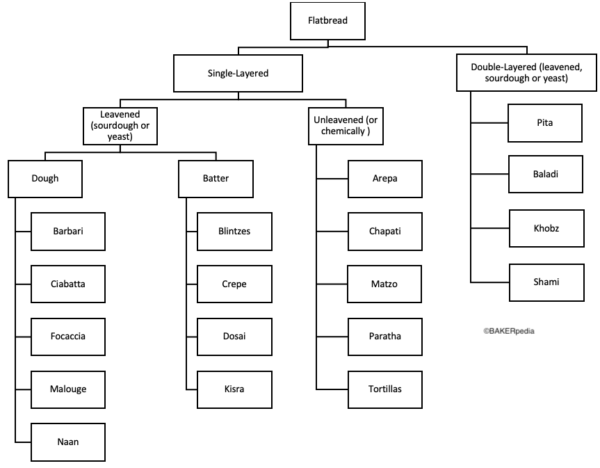
Flatbread
What is Flatbread?
Flatbread is a unique class of baked products characterized by its low specific volume and high crust-to-crumb ratio. They can be consumed as a side dish with several meals and is the staple food of many Middle Eastern, Asian and African cultures.1
Some examples are pita bread, chapati or naan. Flatbreads are classified into two main categories:1
- Single-layered breads which can be:
- Leavened/fermented
- Non-leavened
- Double layer breads
Categories of flatbreads2

Origin
Flatbread is considered an ancient food dating back to 6000 years ago. It is a staple bakery product in the Middle East, North Africa, India, Central America, China and Europe. Today, flatbread is consumed on a daily basis by over 1.5 billion people worldwide.1,3
Typical Formulation2
| Ingredients | Pita Bread | Chapati | Naan |
| Flour | 63.75% | 62.50% | 61.69% |
| Water | 35.06% | 37.50% | 21.59% |
| Salt | 0.71% | Optional | 0.68% |
| Yeast | 0.48% | – | 0.62% |
| Yogurt | – | – | 15.42% |
Nutrition
Typical nutritional values of flatbreads (g/per 100 g bread):4,5,6
| Component | Pita Bread | Chapati | Naan |
| Water | 29.83 | 33.00 | 29.24 |
| Protein | 10.71 | 11.25 | 11.09 |
| Fat | 2.32 | 7.45 | 7.28 |
| Carbohydrate | 57.14 | 46.36 | 52.39 |
| Ash | – | 1.94 | – |
Flatbread is a good source of B-vitamins such as thiamine, riboflavin and niacin. High extraction flour-based formulations can be a good source of dietary fiber.1
Commercial production7
General flatbread commercial production process for flatbreads involves:
- Selection of ingredients: wheat flour, water, salt, yeast or baking powder (depending on the type). Other ingredients such as butter or milk can be added to enhance aroma and taste.
- Mixing: uniform mixing and kneading to form a dough.
- Resting: dough is left to rest about 30-60 min to allow gluten development.
- Fermentation: various time-temperature combinations can be used. Dough may be left to proof for 1-3 h at temperatures from 20-35 °C (68-95°F).
- Sheeting: balls of dough are formed and flattened or sheeted into a circular form.
- Baking: flatbreads can be baked at various temperatures (350-550°C / 662-1022°F) and times.
- Cooling: the baked flatbreads are allowed to cool down.
- Packaging: flatbreads can be packaged in common bags, vacuum sealed or frozen depending on the end-use.
Application1,2
Baking requirements for various flat bread recipes can be found in the following table:
| Conditions | Pita Bread | Chapati | Naan |
| Leavening Agent | Yeast | Chemical | Yeast |
| Proofing Time | 20 min | Short Time | 5 min |
| Temperature | 350-550 °C (662-1022°F) | 220 °C (428°F) | 315 °C (599°F) |
| Cooking Time | <20 s | 45 s on one side and 90 s on the other side | 2 min |
| Cooking Method | Oven | Hot Plate | Oven |
Other considerations when producing flatbreads:
- Low-fat breads have a limited shelf-life.
- Long resting periods may negatively impact bread quality.
- The most important physical qualities of flatbreads are: softness, flexibility and strength due to its use as an eating utensil.
- Even though flatbreads have a lower moisture content than common breads, they are still prone to spoilage due to their relatively high water activity (0.88-0.96). Immediate consumption is advised.
FDA regulations
Flatbreads do not have any specific FDA regulations, however special considerations for ingredients use and their GRAS status should be observed.
References
- Wrigley, C., Corke, H., Seetharaman, K and Faubion, J . Encyclopedia of food grains. 2 nd ed., Academic Press, 2015, pp. 19-23.
- Qarooni, J. Flat bread technology. 1 st ed., Springer Science & Business Media, 1996, pp. 70,160-171
- Mir, S.A and Manzoor,A.S. “Indian Flatbreads: How Structure Influences Properties.” 2019: 90-95.
- U.S. Department of Agriculture, Agricultural Research Service. FoodData Central, 23 August 2018. https://fdc.nal.usda.gov/fdc-app.html#/food-details/367902/nutrients. Accessed 26 June 2020.
- U.S. Department of Agriculture, Agricultural Research Service. FoodData Central, 31 December 2019. https://fdc.nal.usda.gov/fdc-app.html#/food-details/171844/nutrients. Accessed 26 June 2020.
- U.S. Department of Agriculture, Agricultural Research Service. FoodData Central, 31 December 2019. https://fdc.nal.usda.gov/fdc-app.html#/food-details/784494/nutrients. Accessed 26 June 2020.
- Tamang, J. P . Ethnic Fermented Foods and Beverages of India: Science History and Culture.1 st ed., Springer Nature, 2020, p. 234.

